'Let Electricity Work For You',
Coprolite Street (derivation), Grimwade Hall
Possibly the ugliest building in Ipswich up until
recently, this Electricity
sub-station with its iron-plated frontage and just-readable lettering:
'Electricity
Work For You' (perhaps it had a 'Let' in front of it?) lies on Duke
Street,
facing the end of Coprolite Street. The whole area was being
transformed
in 2005 as part of the Waterfont
Regeneration involving demolition of silos, development and
building work until the global financial crash of 2007-8 and this electricity sub-station is no exception. Most would agree that it's an improvement on
the empty dock and deserted
wharves. The
nearby, long-disused Grimwade Memorial Hall (see below) on the corner
of Back Hamlet and Fore
Hamlet has undergone a good refurbishment with decorative
stonework and restored brick details; needless to say it's now flats.
Duke Street
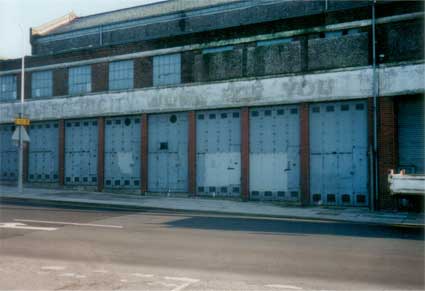 2003 images
2003 images

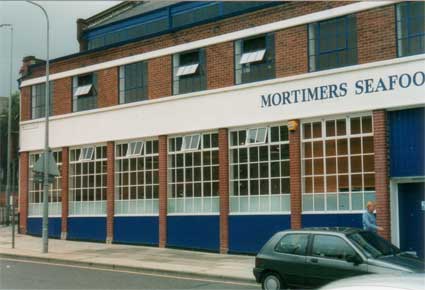
The above is now a glittering fish restaurant in glass
and chrome, Mortimers Seafood
(later Loch Fyne, The Forge) having moved from a building next to Christies Warehouse on the Wet Dock,
to be replaced by a
bistro. The shape of things to come... Now a vague memory: here's that
slogan
of yore:
'LET ELECTRICITY WORK FOR YOU'
See our page on Public
clocks in Ipswich for a 2018 view of the restaurant (now The Forge)
frontage and its clock.
Coprolite Street
Coprolite: a definition
'Copralite' suggests 'fossilised dinosaur dung' or 'fossilised sea
serpent dung' – other fanciful definitions are popular, probably
because they make a story people want to believe. In fact, the actual
definition is a bit more down-to-earth (literally – see below).
But people prefer to cling to the fossilised dung story.
Coprolite Street gained its name from the fertiliser
plant (called rather quirkily 'Manure Manufactory' on maps) owned by the pioneering Edward Packard built at the dock
end of
this street in 1850,
which produced artificial fertiliser used to improve agricultural
soils.
Coprolites are nitrogenous fossil nodules, which
are
contained in the red crag beneath large areas of eastern Suffolk. The nodules contain high levels of calcium phosphate which,
it was discovered, can be ground up and, by the application of
sulphuric
acid, converted into superphosphate,
better known as chemical (or artificial) fertiliser. Coprolites were
first dug
in 1817 by Edmund Edwards, a farmer at Levington. The idea was
eventually taken up by Darwin's mentor and second President of the Ipswich Museum, the Rev. John Stevens Henslow;
he was a former Professor of Botany and Mineralogy at Cambridge
University who
retired to become the rector of Hitcham, Suffolk. Coprolite was dug in
particular from the banks of Suffolk rivers the Orwell and the Deben.
Apparently, the inhabitants of Trimley St Mary and Trimley St Martin
were called treacle miners because of the coprolite that was dug there.
Packard's original coprolite works were sited on today's 'Neptune
Marina'
block of
flats on the south side of Coprolite Street (and today the Suffolk
University Waterfront Building is on the north side). Below is a
photograph
from the nineteen-sixties(?) of the factory; the first two gables are
probably the extent of the works. The 1867 map
of the area on our Ransomes
Orwell Works site shows the relatively small size of the works
(marked 'Factory'). Ironically, the factory here only lasted from the
late 1840s to 1854 because of the acidic fumes produced during
processing. The business was moved to works off Paper Mill Lane at
Bramford, which eventually grew into the giant Fisons Fertilisers
business. On the photograph, the fascade with teagle door and
overhanging gantry facing the waterfront is part of the Ransomes iron
works. Coprolite Street (with cars
parked) runs away from the water towards the Electricity sub-station.
Above the car nearest to the corner is affixed to the filthy 'Suffolk
whites' wall the street nameplate with superior 'T' in 'Street'.
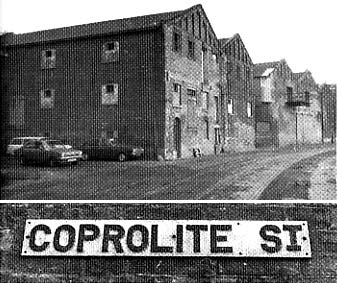 1960s(?) images
1960s(?) images
Below: here is the 21st century street nameplate (with coloured Borough coat of arms) in more or less the same
position: today, beside the entrance to 'Neptune Marina' (tower block)
car park entrance and the corner of Coffee Link.
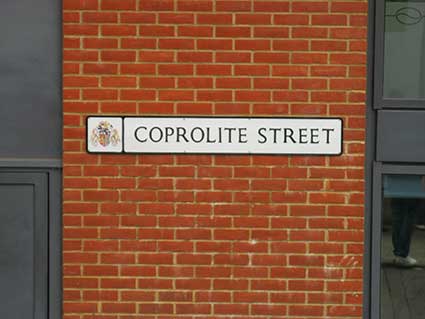 2015
image
2015
image
Below: a 1970s photograph from The Ipswich Society's Image Archive (see
Links) showing the corner of the former
Packard's artificial fertiliser works and Duke Street. The large metal
sign: 'FISONS LIMITED' has been crudely whitwewashed over,
suggesting that the works were unused at this time. The arched
loading door: ''KEEP CLEAR FOR LORRIES LOADING' is also of interest.
Just visible at the extreme left is Spurdens newsagent's shop on the
other side of Duke Street which still operates today. Since the Waterfront Regeneration scheme
this corner has been occupied by the Duke Street entrance to the rear
of the Neptune Marina block.
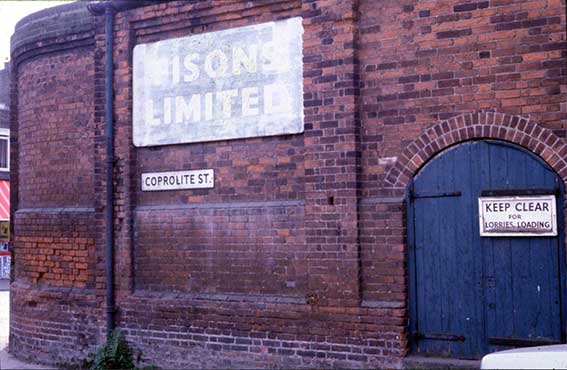 1970s
image courtesy The Ipswich Society
1970s
image courtesy The Ipswich Society
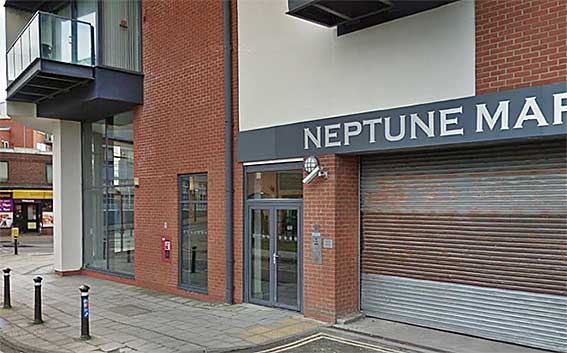 2021
comparison
2021
comparison
The Suffolk coprolite industry: a look at an almost forgotten
industry of Victorian Suffolk
by geologist Bob Markham
The element phosphorous is an essential ingredient of the bones of our
skeleton (as calcium phosphate) and which we get from our food. But a
field with no phosphate in the soil is incapable of producing grain,
peas or beans.
‘Coprolite’ stones were discovered by a clergyman Professor*** on
holiday at Felixstowe, Suffolk and their
phosphate content was responsible for the local fertiliser industry.
The 1840s were a time of shortage of phosphatic manure and ‘soluble’
superphosphate from coprolit was a new and welcoming way to increase
the food supply of England.
The industry lasted from about 1847 to 1895, superseded by phosphate
from Cambridgeshire, France and South Carolina.
Initially thought to be coprolite (fossil faeces), these nodules from
the Suffolk Pliocene age Red Crag were shown to be derived from London
clay. It was due to this that the word ‘coprolite’ became the
commercial term for these phosphatic nodules. The phosphate mineral is
Francolite (Carbonate Fluorapatite); it is enriched by upwelling marine
water before precipitation to form phosphatic rock.
---
***In 1842 the Rev. John Stevens Henslow, a professor of Botany at St
John's College, Cambridge, discovered coprolites just outside
Felixstowe in the villages of Trimley St Martin, Falkenham and Kirton
and investigated their composition. Henslow was appointed the President
of the Ipswich Museum in 1850, also the
mentor of Charles Darwin, which links Darwin to Ipswich; Arlington’s
restaurant has named the Darwin Room after him. See also Street name derivations for Henslow Road.
Realising their potential as a source of available phosphate once they
had been treated with sulphuric acid, he patented an extraction process
and set about finding new sources. Very soon, coprolites were being
mined on an industrial scale for use as fertiliser due to their high
phosphate content. The major area of extraction occurred over the east
of England, centred on Cambridgeshire and the Isle of Ely with its
refining being carried out in Ipswich. The ‘Manure Manufactory’, as it
is shown on 1902 and 1930 maps, stood on the south-western end of
Coprolite Street – the site of today’s Neptune Marina apartment block.
It was originally set up by Edward Packard, a well-known name in local
business and politics. His son, Sir Edward Packard, Junior (1843-1932)
developed Packard and James Fison (Thetford) Limited (later known as
'Fisons') into one of the largest fertiliser manufacturing businesses
in the country.
Perhaps it’s one of those classic cases where we have all accepted the
“fossilised dinosaur dung” source of these phosphatic nodules, mainly
because it makes a good story, but the truth is that they develop
naturally within clay (they are still turning up at the nearby
Brickmakers Wood, see our Brickyards
page), so they really should have inverted commas around ‘coprolites’.
And the 'Manure Manufactory' is rather misleadingly named.
Coprolite firms in Ipswich
‘About 1880 there were no fewer than five firms operating as
manufacturers of artificial manures in the area, all with offices and
some with warehouses in Ipswich.
• Henry Chapman and Co. had its
head office on the Cornhill and works at Bramford;
• William Colchester was at
Griffin Wharf, on the Stoke side of the Orwell;
• Joseph Fison & Co. had works
both at Bramford and Ipswich and offices at Eastern Union Mills, close
by Stoke Bridge;
• Edward Packard & Co. had
works at Bramford and offices at Princes Street, Ipswich;
• Prentice Bros., whose main works
were at Stowmarket, had premises at Flint Wharf, Ipswich.
Three of these firms were eventually to be united under the title of
Fison, Packard & Prentice Ltd, and were to become the basis of the
world-famous Fisons Ltd which is still firmly based in Suffolk.±’
R. Malster: Ipswich town on the
Orwell (1978)
[±By 1995 Fisons was being broken up
and sold to larger multinationals.]
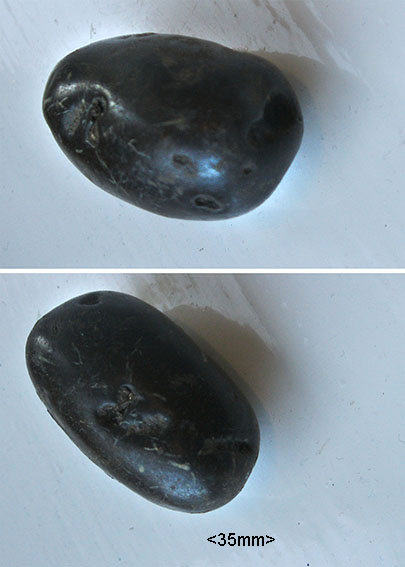
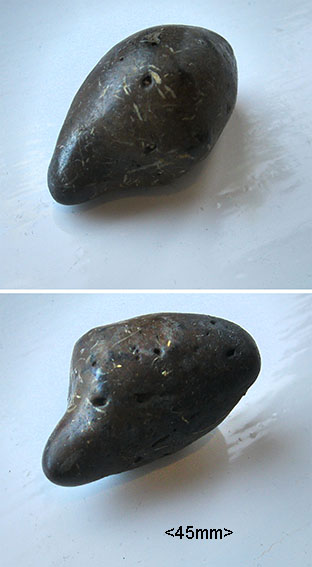 2018 images
2018 images
The above examples of coprolite were two of many found near the
surface of the scarp at Brickmakers Wood (see Links),
to the south-west of Alexandra Park.
This is the area close
to Coprolite Street where clay was dug for the brick and tile works after which the
Potteries area was named; you can see the location of Brickmakers
Wood on that page.
[UPDATE 26.6.2019: GeoSuffolk,
the group studying and communicating the geology of the county (see Links) have published a leaflet about Coprolites (click to view the
PDF).
Grimwade Memorial Hall
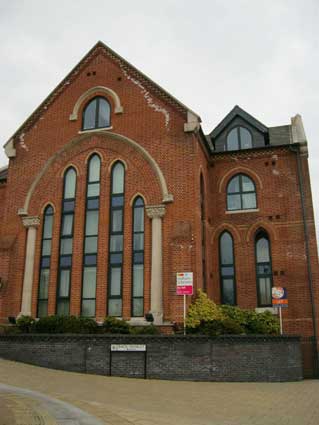 2013
images
2013
images 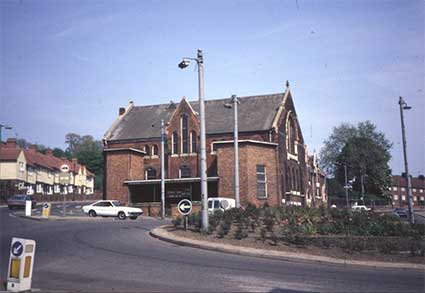 1980s image courtesy of The Ipswich
Society
1980s image courtesy of The Ipswich
Society
At the junction of Back Hamlet and Fore Hamlet sits the former 19th
century Grimwade Memorial Hall, since the 2006 conversion it is 35
flats. The 1980s photograph, above, comes from The Ipswich Society's
Image Archive (see Links); note the way in
which an attractive gothic-style church building had been disfigured by
the rather brutal side-wings with a flat-roofed canopy between. Beneath
the canopy, part of a sign reads 'COME ON IN', presumably promoting
services or meetings within. In the foreground in the rather slope-y
Duke Street roundabout which enabled 'the traffic to keep moving' but
also resulted in the death of a cyclist and perillous crossing of
surrounding roads by pedestrians. This junction is now traffic-light
controlled. A fair bit of demolition and
remodelling of the Grimwade Memorial Hall elevation in 2006 has transformed the scene here.
For a note about its
original purpose, see our St
Clement Congregational Church page. The restored building
carries lettering tablets old and new, plus an attractive stonework
doorway, both on the Fore Hamlet pavement.
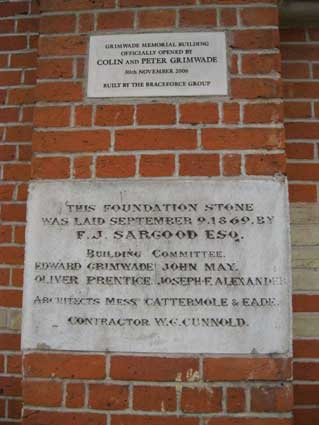
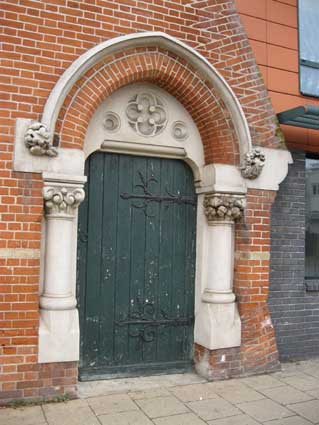
'GRIMWADE MEMORIAL
BUILDING
OFFICIALLY OPENED BY
COLIN AND PETER GRIMWADE
30th NOVEMBER 2006
BUILT BY THE BRACEFORCE GROUP'
'THIS FOUNDATION STONE
WAS LAID SEPTEMBER 9.1869, BY
F.J. SARGOOD ESQ.
BUILDING COMMITTEE.
EDWARD GRIMWADE. JOHN MAY.
OLIVER PRENTICE. JOSEPH F. ALEXANDER.
ARCHITECTS MESSRS. CATTERMOLE & EADE.
CONTRACTOR W.G. CUNNOLD.'
The Grimwade name has been closely associated with
Ipswich for more than a century, with the family providing four mayors
and running a department store on the Cornhill,
which closed in1995. The Grimwade name can be also found on Hope House.
See also our Fore Street 1620 page
for an 1881 map of the area and The
Steampacket Inn.
See our Street name derivations for the
nearby Grimwade Street.
Related pages:
Christie's
warehouse
Bridge
Street
Burton Son & Sanders / Paul's
College Street
Cranfield's
Flour Mill
Custom House
Trinity
House buoy
Edward
Fison Ltd
Ground-level dockside furniture
on: 'The
island', the northern quays
and Ransome's
Orwell Works
Ipswich
Whaling Station?
Isaac Lord
Neptune Inn
clock, garden
and interior
Isaac
Lord 2
The Island
John Good and Sons
Merchant
seamen's memorial
The Mill
Nova Scotia
House
New Cut East
Quay
nameplates
The Question Mark
R&W Paul malting company
Ransomes
Steam
Packet Hotel
Stoke
Bridge(s)
Waterfront
Regeneration Scheme
Wolsey's
Gate
A chance to
compare
Wet Dock 1970s with 2004
Wet Dock maps
Davy's
illustration of the laying of the Wet Dock lock foundation stone,
1839
Outside
the Wet Dock
Maritime Ipswich '82 festival
Home
Please email any comments and contributions by clicking here.
Search Ipswich
Historic Lettering
©2004 Copyright
throughout the Ipswich
Historic Lettering site: Borin Van Loon
No reproduction of text or images without express written permission

 2003 images
2003 images

 1960s(?) images
1960s(?) images 2015
image
2015
image 1970s
image courtesy The Ipswich Society
1970s
image courtesy The Ipswich Society 2021
comparison
2021
comparison
 2018 images
2018 images 2013
images
2013
images  1980s image courtesy of The Ipswich
Society
1980s image courtesy of The Ipswich
Society
